Quantitative Estimation of Vegetation Carbon Source/Sink and Its Response to Climate Variability and Anthropogenic Activities in Dongting Lake Wetland, China
Abstract
1. Introduction
2. Materials and Methods
2.1. Study Area
2.2. Data and Preprocessing
2.2.1. Remote Sensing Data
2.2.2. Wetland Classification Data
2.2.3. Hydrology and Meteorological Data
2.2.4. Field Measurement Data
2.2.5. Soil Organic Carbon Density Data
2.2.6. Auxiliary Data
2.3. Methodology
2.3.1. Vegetation Classification Using Support Vector Machine Method
2.3.2. Improved CASA Model for NPP and NEP Estimation
2.3.3. Theil-Sen Median Trend Analysis and Modified Mann-Kendall Test
2.3.4. Partial Correlation Analysis and Attribution of Climatic and Anthropogenic Impacts on NEP Changes
3. Results
3.1. Applicability of Vegetation NPP/NEP Based on CASA Model
3.2. Spatiotemporal Dynamics of NEP and Vegetation Carbon Sink Capacity
3.2.1. Spatial Distribution of NEP and Carbon Sink Patterns
3.2.2. Temporal Variations in NEP and Carbon Sink Capacity
3.3. Driving Force of Vegetation NEP Dynamics
3.3.1. Interrelationships Between Climatic Factors and Vegetation NEP
3.3.2. Interrelationships Between Land Use and Vegetation NEP
3.3.3. Interrelationships Between Socio-Economic Factors and Vegetation NEP
3.3.4. Interrelationships Between Water Level and Vegetation NEP
3.3.5. Quantifying Climate Change and Anthropogenic Contributions to NEP Variations
4. Discussion
4.1. Comparison of NEP Trends and Variations in the Dongting Lake Wetland (2002–2022)
4.2. Climate, Land Use, and Hydrology as Drivers of NEP Change in Lake Wetlands
4.3. Insights into the Balance of Climatic and Human Influences on Sustainable Wetland Carbon Sequestration
4.4. Limitations and Future Research Directions
5. Conclusions
- (1)
- The estimated NPP was slightly lower than the MOD17A3 product, with a multi-year mean relative error of 22.92%, which fell within the acceptable range (10–30%) for wetland carbon modeling, demonstrating good consistency with previous studies and supporting the reliability of the NEP estimates.
- (2)
- Annual NEP ranged from −342.70 to 529.08 g C/m2/a, showing an initial rise followed by a decline, with an overall decreasing trend of −1.5 g C/m2/a. Monthly NEP varied from −31.45 to 85.76 g C/m2/month, spring exhibited stronger carbon sink effects than summer, while winter acted as a carbon source.
- (3)
- Climate change contributions to NEP ranged from −48.11 to 71.33 g C/m2/a, averaging 2.17 g C/m2/a. Positive effects were concentrated in permanently vegetated areas, with solar radiation showing the strongest positive correlation. Precipitation had a negative annual correlation with NEP but weakly positive monthly correlations.
- (4)
- Human activities contributed between −47.34 and 18.40 g C/m2/a, averaging −3.73 g C/m2/a, with positive and negative impacts inversely distributed compared to climate change. Human activities dominated carbon sink degradation (74.30%), while climate change drove enhancement (25.70%).
- (5)
- Climate change has increasingly constrained wetland carbon sequestration, with its contribution to NEP shifting from +11.25 g C/m2/a (2000–2011) to −11.77 g C/m2/a (2011–2022). To enhance carbon sink resilience, further research and adaptive strategies are needed to mitigate the long-term climatic impacts on wetland ecosystems.
- (6)
- Positive human interventions, such as forest expansion and the conversion of cropland and reed to sedge, significantly enhanced carbon sequestration and should be promoted. Additionally, maintaining water levels within the optimal range of 24.06–26.44 m during the growing season is recommended to sustain wetland carbon sink capacity.
Author Contributions
Funding
Data Availability Statement
Acknowledgments
Conflicts of Interest
Appendix A
| Year | Classified/Reference | Build-Up | Cropland | Mudflat | Reed | Sedge | Water | Woodland | User’s Accuracy (%) |
|---|---|---|---|---|---|---|---|---|---|
| 2000 | build-up | 297 | 101 | 0 | 39 | 0 | 0 | 23 | 64.56 |
| cropland | 212 | 1916 | 43 | 99 | 347 | 28 | 108 | 69.59 | |
| mudflat | 0 | 1 | 65 | 0 | 63 | 59 | 0 | 34.57 | |
| reed | 59 | 54 | 0 | 4078 | 93 | 5 | 224 | 90.36 | |
| sedge | 3 | 340 | 18 | 584 | 2029 | 9 | 22 | 67.52 | |
| water | 7 | 232 | 303 | 214 | 756 | 9810 | 34 | 86.38 | |
| woodland | 0 | 0 | 0 | 0 | 0 | 0 | 0 | 0 | |
| Producer’s Accuracy (%) | 51.38 | 72.46 | 15.15 | 81.33 | 61.70 | 98.98 | 0 | ||
| Overall Accuracy | 81.68 | Kappa Coefficient | 0.735 | ||||||
| 2011 | build-up | 63 | 7 | 0 | 0 | 0 | 5 | 84.00 | |
| cropland | 97 | 1445 | 47 | 55 | 140 | 62 | 128 | 73.20 | |
| mudflat | 0 | 12 | 249 | 0 | 40 | 189 | 0 | 50.81 | |
| reed | 9 | 89 | 1 | 4651 | 544 | 33 | 60 | 86.33 | |
| sedge | 100 | 294 | 151 | 441 | 3827 | 357 | 67 | 73.07 | |
| water | 21 | 130 | 79 | 0 | 81 | 7316 | 12 | 95.77 | |
| woodland | 5 | 177 | 38 | 65 | 21 | 10 | 513 | 61.88 | |
| Producer’s Accuracy (%) | 21.35 | 67.08 | 44.07 | 89.23 | 82.24 | 91.77 | 65.76 | ||
| Overall Accuracy | 83.50 | Kappa Coefficient | 0.779 | ||||||
| 2022 | build-up | 260 | 51 | 58 | 76 | 16 | 0 | 10 | 55.20 |
| cropland | 44 | 1780 | 49 | 37 | 381 | 205 | 62 | 69.58 | |
| mudflat | 49 | 19 | 52 | 0 | 0 | 2 | 0 | 42.62 | |
| reed | 7 | 33 | 35 | 4449 | 753 | 18 | 149 | 81.72 | |
| sedge | 213 | 276 | 87 | 1405 | 5244 | 5 | 124 | 71.30 | |
| water | 3 | 606 | 162 | 12 | 149 | 11,418 | 42 | 1.20 | |
| woodland | 2 | 12 | 0 | 15 | 5 | 0 | 94 | 73.43 | |
| Producer’s Accuracy (%) | 44.98 | 64.09 | 11.73 | 74.22 | 80.08 | 98.02 | 19.54 | ||
| Overall Accuracy | 81.83 | Kappa Coefficient | 0.745 | ||||||
References
- IPCC. Synthesis Report of the IPCC Sixth Assessment Report (AR6), Longer Report; Lee, H., Calvin, K., Dasgupta, D., Krinmer, G., Mukherji, A., Thorne, P., Trisos, C., Romero, J., Aldunce, P., Barret, K., Eds.; IPCC: Geneva, Switzerland, 2023. [Google Scholar]
- Xiao, D.; Deng, L.; Kim, D.G.; Huang, C.; Tian, K. Carbon budgets of wetland ecosystems in China. Glob. Change Biol. 2019, 25, 2061–2076. [Google Scholar] [CrossRef]
- Davidson, N.C.; Finlayson, C.M. Extent, regional distribution and changes in area of different classes of wetland. Mar. Freshw. Res. 2018, 69, 1525–1533. [Google Scholar] [CrossRef]
- Ye, X.; Meng, Y.; Xu, L.; Xu, C. Net primary productivity dynamics and associated hydrological driving factors in the floodplain wetland of China’s largest freshwater lake. Sci. Total Environ. 2019, 659, 302–313. [Google Scholar] [CrossRef] [PubMed]
- Rosentreter, J.A.; Borges, A.V.; Deemer, B.R.; Holgerson, M.A.; Liu, S.; Song, C.; Melack, J.; Raymond, P.A.; Duarte, C.M.; Allen, G.H. Half of global methane emissions come from highly variable aquatic ecosystem sources. Nat. Geosci. 2021, 14, 225–230. [Google Scholar] [CrossRef]
- Mitsch, W.J.; Bernal, B.; Nahlik, A.M.; Mander, Ü.; Zhang, L.; Anderson, C.J.; Jørgensen, S.E.; Brix, H. Wetlands, carbon, and climate change. Landsc. Ecol. 2013, 28, 583–597. [Google Scholar] [CrossRef]
- Yang, L.; Wang, L.; Yu, D.; Yao, R.; He, Q.; Wang, S.; Wang, L. Four decades of wetland changes in Dongting Lake using Landsat observations during 1978–2018. J. Hydrol. 2020, 587, 124954. [Google Scholar] [CrossRef]
- Nag, S.K.; Ghosh, B.D.; Das, B.K.; Sarkar, U.K. Wetlands function as carbon sink: Evaluation of few floodplains of middle Assam, northeast India in the perspective of climate change. J. Environ. Manag. 2025, 373, 123841. [Google Scholar] [CrossRef]
- Jin, Y.; Li, J.; Liu, C.; Liu, Y.; Zhang, Y.; Song, Q.; Sha, L.; Chen, A.; Yang, D.; Li, P. Response of net primary productivity to precipitation exclusion in a savanna ecosystem. For. Ecol. Manag. 2018, 429, 69–76. [Google Scholar] [CrossRef]
- Cloern, J.E.; Safran, S.M.; Vaughn, L.S.; Robinson, A.; Whipple, A.A.; Boyer, K.E.; Drexler, J.Z.; Naiman, R.J.; Pinckney, J.L.; Howe, E.R. On the human appropriation of wetland primary production. Sci. Total Environ. 2021, 785, 147097. [Google Scholar] [CrossRef]
- Waldo, S.; Chi, J.; Pressley, S.N.; O’Keeffe, P.; Pan, W.L.; Brooks, E.S.; Huggins, D.R.; Stöckle, C.O.; Lamb, B.K. Assessing carbon dynamics at high and low rainfall agricultural sites in the inland Pacific Northwest US using the eddy covariance method. Agric. For. Meteorol. 2016, 218, 25–36. [Google Scholar] [CrossRef]
- Zhu, W.; Pan, Y.; He, H.; Yu, D.; Hu, H. Simulation of maximum light use efficiency for some typical vegetation types in China. Chin. Sci. Bull. 2006, 51, 457–463. [Google Scholar] [CrossRef]
- Crabtree, R.; Potter, C.; Mullen, R.; Sheldon, J.; Huang, S.; Harmsen, J.; Rodman, A.; Jean, C. A modeling and spatio-temporal analysis framework for monitoring environmental change using NPP as an ecosystem indicator. Remote Sens. Environ. 2009, 113, 1486–1496. [Google Scholar] [CrossRef]
- Field, C.B.; Randerson, J.T.; Malmström, C.M. Global net primary production: Combining ecology and remote sensing. Remote Sens. Environ. 1995, 51, 74–88. [Google Scholar] [CrossRef]
- Chen, S.; Jiang, H.; Chen, Y.; Cai, Z. Spatial-temporal patterns of net primary production in Anji (China) between 1984 and 2014. Ecol. Indic. 2020, 110, 105954. [Google Scholar] [CrossRef]
- Seixas, J.; Carvalhais, N.; Nunes, C.; Benali, A. Comparative analysis of MODIS-FAPAR and MERIS–MGVI datasets: Potential impacts on ecosystem modeling. Remote Sens. Environ. 2009, 113, 2547–2559. [Google Scholar] [CrossRef]
- Chuai, X.; Qi, X.; Zhang, X.; Li, J.; Yuan, Y.; Guo, X.; Huang, X.; Park, S.; Zhao, R.; Xie, X. Land degradation monitoring using terrestrial ecosystem carbon sinks/sources and their response to climate change in China. Land Degrad. Dev. 2018, 29, 3489–3502. [Google Scholar] [CrossRef]
- Yu, G.; Zheng, Z.; Wang, Q.; Fu, Y.; Zhuang, J.; Sun, X.; Wang, Y. Spatiotemporal pattern of soil respiration of terrestrial ecosystems in China: The development of a geostatistical model and its simulation. Environ. Sci. Technol. 2010, 44, 6074–6080. [Google Scholar] [CrossRef]
- Lyu, J.; Fu, X.; Lu, C.; Zhang, Y.; Luo, P.; Guo, P.; Huo, A.; Zhou, M. Quantitative assessment of spatiotemporal dynamics in vegetation NPP, NEP and carbon sink capacity in the Weihe River Basin from 2001 to 2020. J. Clean. Prod. 2023, 428, 139384. [Google Scholar] [CrossRef]
- Zhang, C.; Zhen, H.; Zhang, S.; Tang, C. Dynamic changes in net primary productivity of marsh wetland vegetation in China from 2005 to 2015. Ecol. Indic. 2023, 155, 110970. [Google Scholar] [CrossRef]
- Yang, H.; Zhong, X.; Deng, S.; Xu, H. Assessment of the impact of LUCC on NPP and its influencing factors in the Yangtze River basin, China. CATENA 2021, 206, 105542. [Google Scholar] [CrossRef]
- Zheng, B.; Wu, S.; Liu, Z.; Wu, H.; Li, Z.; Ye, R.; Zhu, J.; Wan, W. Downscaling estimation of NEP in the ecologically-oriented county based on multi-source remote sensing data. Ecol. Indic. 2024, 160, 111818. [Google Scholar] [CrossRef]
- Qiao, W.; Hu, B.; Kattel, G.R.; Liu, J. Impact of urbanization on net carbon sink efficiency in economically developed area: A case study of the Yangtze River Delta urban agglomeration, China. Ecol. Indic. 2023, 157, 111211. [Google Scholar] [CrossRef]
- Maziarz, J.; Vourlitis, G.L.; Kristan, W. Carbon and nitrogen storage of constructed and natural freshwater wetlands in southern California. Ecol. Eng. 2019, 142, 100008. [Google Scholar] [CrossRef]
- Nath, A.J.; Sileshi, G.W.; Bania, J.K.; Nath, A. Threats to inland wetlands and uncertainty around global soil carbon stocks and sequestration rates. Sci. Total Environ. 2024, 955, 177190. [Google Scholar] [CrossRef]
- Zhang, M.; Yuan, N.; Lin, H.; Liu, Y.; Zhang, H. Quantitative estimation of the factors impacting spatiotemporal variation in NPP in the Dongting Lake wetlands using Landsat time series data for the last two decades. Ecol. Indic. 2022, 135, 108544. [Google Scholar] [CrossRef]
- Tian, F.; Liu, L.; Yang, J.; Wu, J. Vegetation greening in more than 94% of the Yellow River Basin (YRB) region in China during the 21st century caused jointly by warming and anthropogenic activities. Ecol. Indic. 2021, 125, 107479. [Google Scholar] [CrossRef]
- Li, Q.; Zheng, B.; Tu, B.; Yang, Y.; Wang, Z.; Jiang, W.; Yao, K.; Yang, J. Refining urban built-up area via multi-source data fusion for the analysis of dongting lake eco-economic zone spatiotemporal expansion. Remote Sens. 2020, 12, 1797. [Google Scholar] [CrossRef]
- An, X.; Jin, W.; Long, X.; Chen, S.; Qi, S.; Zhang, M. Spatial and temporal evolution of carbon stocks in Dongting Lake wetlands based on remote sensing data. Geocarto Int. 2022, 37, 14983–15009. [Google Scholar] [CrossRef]
- Long, X.; Li, X.; Lin, H.; Zhang, M. Mapping the vegetation distribution and dynamics of a wetland using adaptive-stacking and Google Earth Engine based on multi-source remote sensing data. Int. J. Appl. Earth Obs. Geoinf. 2021, 102, 102453. [Google Scholar] [CrossRef]
- Lai, X.; Jiang, J.; Huang, Q. Effects of the normal operation of the Three Gorges Reservoir on wetland inundation in Dongting Lake, China: A modelling study. Hydrol. Sci. J. 2013, 58, 1467–1477. [Google Scholar] [CrossRef]
- Guo, M.; Zhou, N.; Cai, Y.; Zhao, W.; Lu, S.; Liu, K. Monitoring the Landscape Pattern Dynamics and Driving Forces in Dongting Lake Wetland in China Based on Landsat Images. Water 2024, 16, 1273. [Google Scholar] [CrossRef]
- Guo, D.; Shi, W.; Qian, F.; Wang, S.; Cai, C. Monitoring the spatiotemporal change of Dongting Lake wetland by integrating Landsat and MODIS images, from 2001 to 2020. Ecol. Inform. 2022, 72, 101848. [Google Scholar] [CrossRef]
- Hutchinson, M.F.; Xu, T. ANUSPLIN Version 4.4 User Guide; Centre for Resource and Environmental Studies, The Australian National University: Canberra, Australia, 2013; p. 54. [Google Scholar]
- Yang, J.; Huang, X. The 30 m annual land cover datasets and its dynamics in China from 1985 to 2023. Earth Syst. Sci. Data 2024, 13, 3907–3925. [Google Scholar] [CrossRef]
- Zhu, W.; Pan, Y.; Zhang, J. Estimation of net primary productivity of Chinese terrestrial vegetation based on remote sensing. Chin. J. Plant Ecol. 2007, 31, 413–424. (In Chinese) [Google Scholar]
- Zhang, M. Modeling net primary productivity of wetland with a satellite-based light use efficiency model. Geocarto Int. 2022, 37, 4028–4052. [Google Scholar] [CrossRef]
- Schimel, D.S.; House, J.I.; Hibbard, K.A.; Bousquet, P.; Ciais, P.; Peylin, P.; Braswell, B.H.; Apps, M.J.; Baker, D.; Bondeau, A. Recent patterns and mechanisms of carbon exchange by terrestrial ecosystems. Nature 2001, 414, 169–172. [Google Scholar] [CrossRef]
- Shi, Z. Spatial-Temporal Simulation of Vegetation Carbon Sink and Its Influential Factors Based on CASA and GSMSR Model in Shaanxi Province. Master’s Thesis, Northwest A&F University, Xianyang, China, 2015. (In Chinese). [Google Scholar]
- Du, H.; Yang, S.; Li, Z.; Guo, Z.; Fan, Q. Spatio-temporal Characteristics and Influencing Factors of Carbon Sources/Sinks in the Yangtze River Delta Under Carbon Neutrality Target. Environ. Sci. 2024, 45, 6848–6857. (In Chinese) [Google Scholar] [CrossRef]
- Wang, K.; Xu, M.; Wang, S.; Wang, L.; Tian, H.; Boonprong, S.; Gao, X.; Yang, X.; Guo, H.; Li, J.; et al. Spatiotemporal patterns and driving factors of NDVI changes in the central and Western Asia economic corridor over the past decade. Front. Environ. Sci. 2025, 13, 1546190. [Google Scholar] [CrossRef]
- Hamed, K.H.; Rao, R.A. A modified Mann-Kendall trend test for autocorrelated data. J. Hydrol. 1998, 204, 182–196. [Google Scholar] [CrossRef]
- Lv, G.; Li, X.; Fang, L.; Peng, Y.; Zhang, C.; Yao, J.; Ren, S.; Chen, J.; Men, J.; Zhang, Q.; et al. Disentangling the Influential Factors Driving NPP Decrease in Shandong Province: An Analysis from Time Series Evaluation Using MODIS and CASA Model. Remote Sens. 2024, 16, 1966. [Google Scholar] [CrossRef]
- Wu, C.; Chen, K.; Chongyi, E.; You, X.; He, D.; Hu, L.; Liu, B.; Wang, R.; Shi, Y.; Li, C.; et al. Improved CASA model based on satellite remote sensing data: Simulating net primary productivity of Qinghai Lake basin alpine grassland. Geosci. Model Dev. 2022, 15, 6919–6933. [Google Scholar] [CrossRef]
- Qi, S.; Chen, S.; Long, X.; An, X.; Zhang, M. Quantitative contribution of climate change and anthropological activities to vegetation carbon storage in the Dongting Lake basin in the last two decades. Adv. Space Res. 2023, 71, 845–868. [Google Scholar] [CrossRef]
- Tian, X.; Huang, Y.; Hu, W.; Li, G.; Li, C.; Yang, R.; Fu, C.; Lei, W. Evaluation of the impact of ecological poplar retreat on the net primary productivity of Lake Wetland. Ecol. Eng. 2025, 212, 107528. [Google Scholar] [CrossRef]
- Xie, Y.; Tang, Y.; Chen, X.; Li, F.; Deng, Z. The impact of Three Gorges Dam on the downstream eco-hydrological environment and vegetation distribution of East Dongting Lake. Ecohydrology 2015, 8, 738–746. [Google Scholar] [CrossRef]
- Lin, X.; Huang, N.; Wang, L.; Liu, J.; Chang, J.; Shi, Y. A dataset of 8-day carbon flux components observations for global terrestrial ecosystems during 1991–2023. Sci. Data Bank 2025, 10, 1–9. [Google Scholar] [CrossRef]
- Wang, S.; Feng, H.; Zou, B.; Yang, Z.; Wang, S. Vegetation Greening Enhanced the Regional Terrestrial Carbon Uptake in the Dongting Lake Basin of China. Forests 2023, 14, 768. [Google Scholar] [CrossRef]
- Pang, B.; Liu, Y.; An, R.; Xie, Y.; Tong, Z.; Liu, Y. Spatial and temporal divergence and driving mechanisms of carbon sinks in terrestrial ecosystems in the middle reaches of the Yangtze River urban agglomerations during 2008–2020. Ecol. Indic. 2024, 165, 112205. [Google Scholar] [CrossRef]
- Wang, L.; Li, Z.; Wang, D.; Chen, J.; Liu, Y.; Nie, X.; Zhang, Y.; Ning, K.; Hu, X. Unbalanced social-ecological development within the Dongting Lake basin: Inspiration from evaluation of ecological restoration projects. J. Clean. Prod. 2021, 315, 128161. [Google Scholar] [CrossRef]
- Li, L.; Zhou, T.; Zhang, W.; Gui, K. Quantifying the extremity of 2022 Chinese Yangtze River Valley daily hot extreme: Fixed or moving baseline matters. Environ. Res. Lett. 2024, 19, 064074. [Google Scholar] [CrossRef]
- Du, X.; Jian, J.; Du, C.; Stewart, R.D. Conservation management decreases surface runoff and soil erosion. Int. Soil Water Conserv. Res. 2022, 10, 188–196. [Google Scholar] [CrossRef]
- Yang, Y.; Wu, C.; An, T.; Yue, T. Characteristics of Climate Change in Poyang Lake Basin and Its Impact on Net Primary Productivity. Sustainability 2024, 16, 9420. [Google Scholar] [CrossRef]
- Xu, X.; Yang, G.; Tan, Y.; Tang, X.; Jiang, H.; Sun, X.; Zhuang, Q.; Li, H. Impacts of land use changes on net ecosystem production in the Taihu Lake Basin of China from 1985 to 2010. J. Geophys. Res. Biogeosci. 2017, 122, 690–707. [Google Scholar] [CrossRef]
- Zhao, Q.; Zhang, T.; Yang, S.; He, Y.; Zhai, T. Moisture-dependent response of soil carbon mineralization to temperature increases in a karst wetland on the Yunnan-Guizhou Plateau. Environ. Sci. Pollut. Res. 2023, 30, 47769–47779. [Google Scholar] [CrossRef] [PubMed]
- Gomes, E.; Inácio, M.; Bogdzevič, K.; Kalinauskas, M.; Karnauskaitė, D.; Pereira, P. Future land-use changes and its impacts on terrestrial ecosystem services: A review. Sci. Total Environ. 2021, 781, 146716. [Google Scholar] [CrossRef]
- Li, C.; Fu, B.; Wang, S.; Stringer, L.C.; Wang, Y.; Li, Z.; Liu, Y.; Zhou, W. Drivers and impacts of changes in China’s drylands. Nat. Rev. Earth Environ. 2021, 2, 858–873. [Google Scholar] [CrossRef]
- Zhang, J.; Liu, M.; Zhang, M.; Yang, J.; Cao, R.; Malhi, S.S. Changes of vegetation carbon sequestration in the tableland of Loess Plateau and its influencing factors. Environ. Sci. Pollut. Res. 2019, 26, 22160–22172. [Google Scholar] [CrossRef]
- Wang, M.; Hu, Z.; Wang, X.; Li, X.; Wang, Y.; Liu, H.; Han, C.; Cai, J.; Zhao, W. Spatio-temporal variation of carbon sources and sinks in the loess plateau under different climatic conditions and land use types. Forests 2023, 14, 1640. [Google Scholar] [CrossRef]
- Li, J.; Jiang, M.; Pei, J.; Fang, C.; Li, B.; Nie, M. Convergence of carbon sink magnitude and water table depth in global wetlands. Ecol. Lett. 2023, 26, 797–804. [Google Scholar] [CrossRef]
- Yu, Z.; Miao, L.; Liu, Q.; Kattel, G.R.; Bao, G.; Chuai, X.; Zhang, Y.; Zhang, H. Uncovering the impact of multiple determinants on vegetation NPP in Inner Mongolia. Glob. Ecol. Conserv. 2024, 56, e03341. [Google Scholar] [CrossRef]
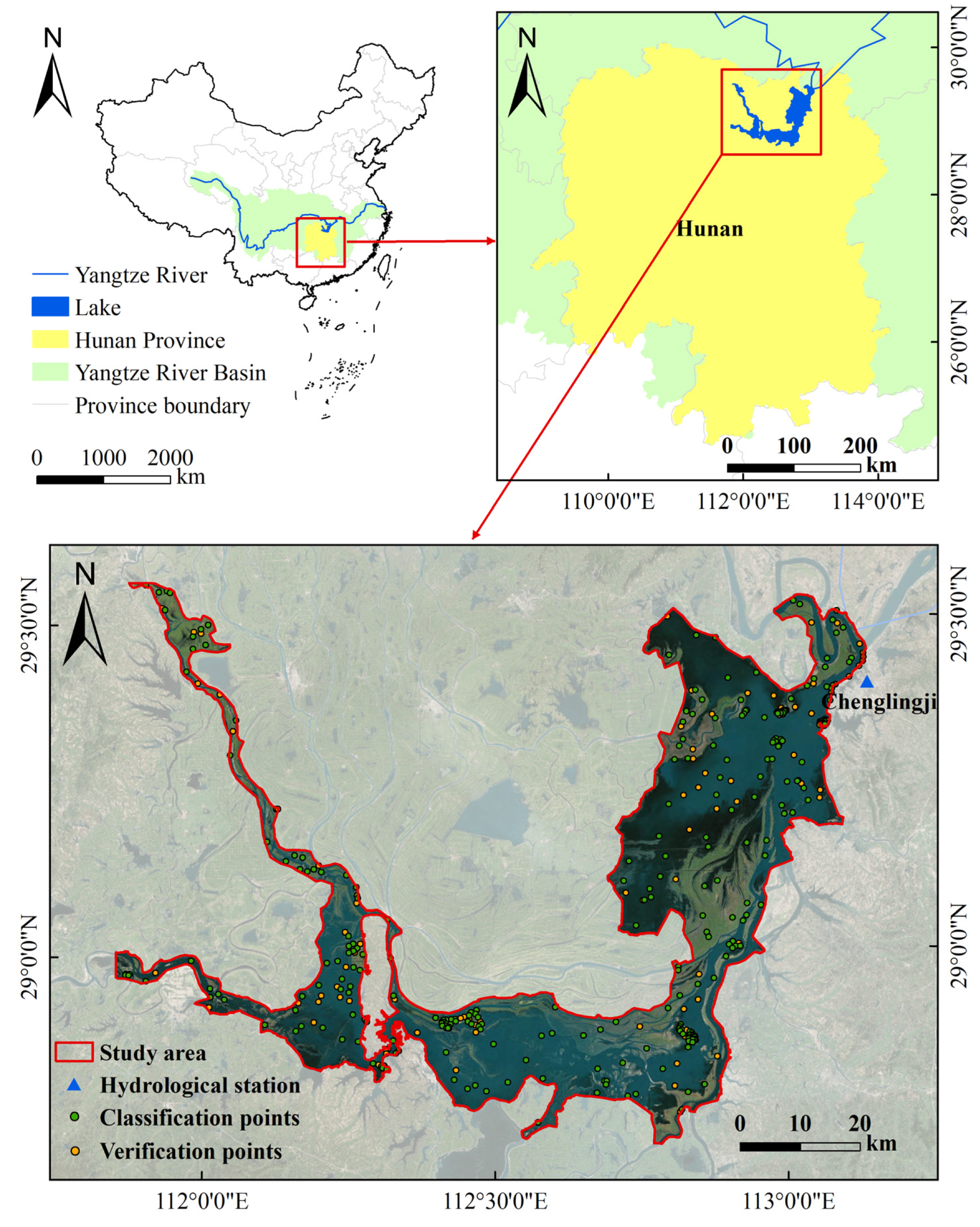
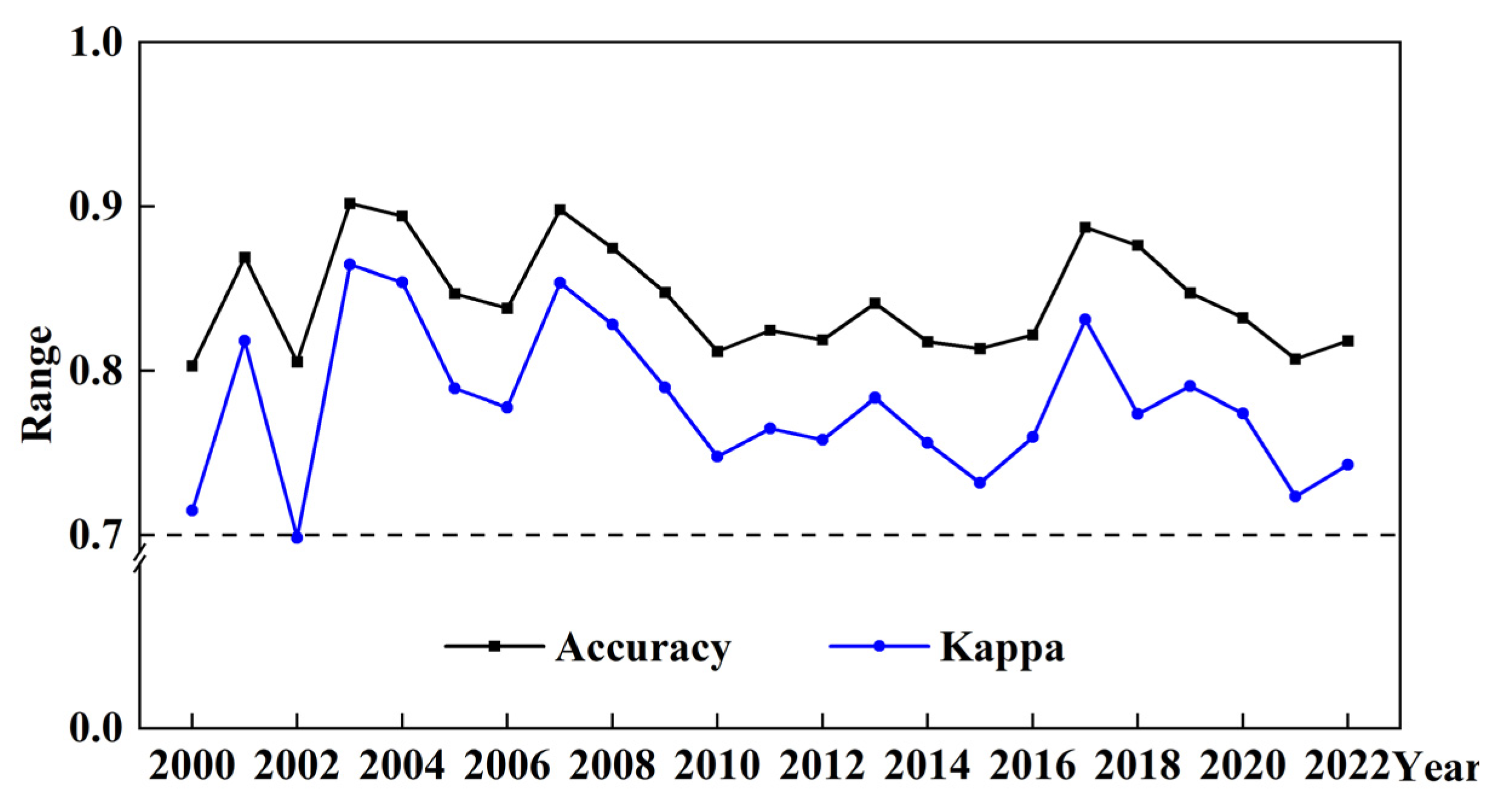
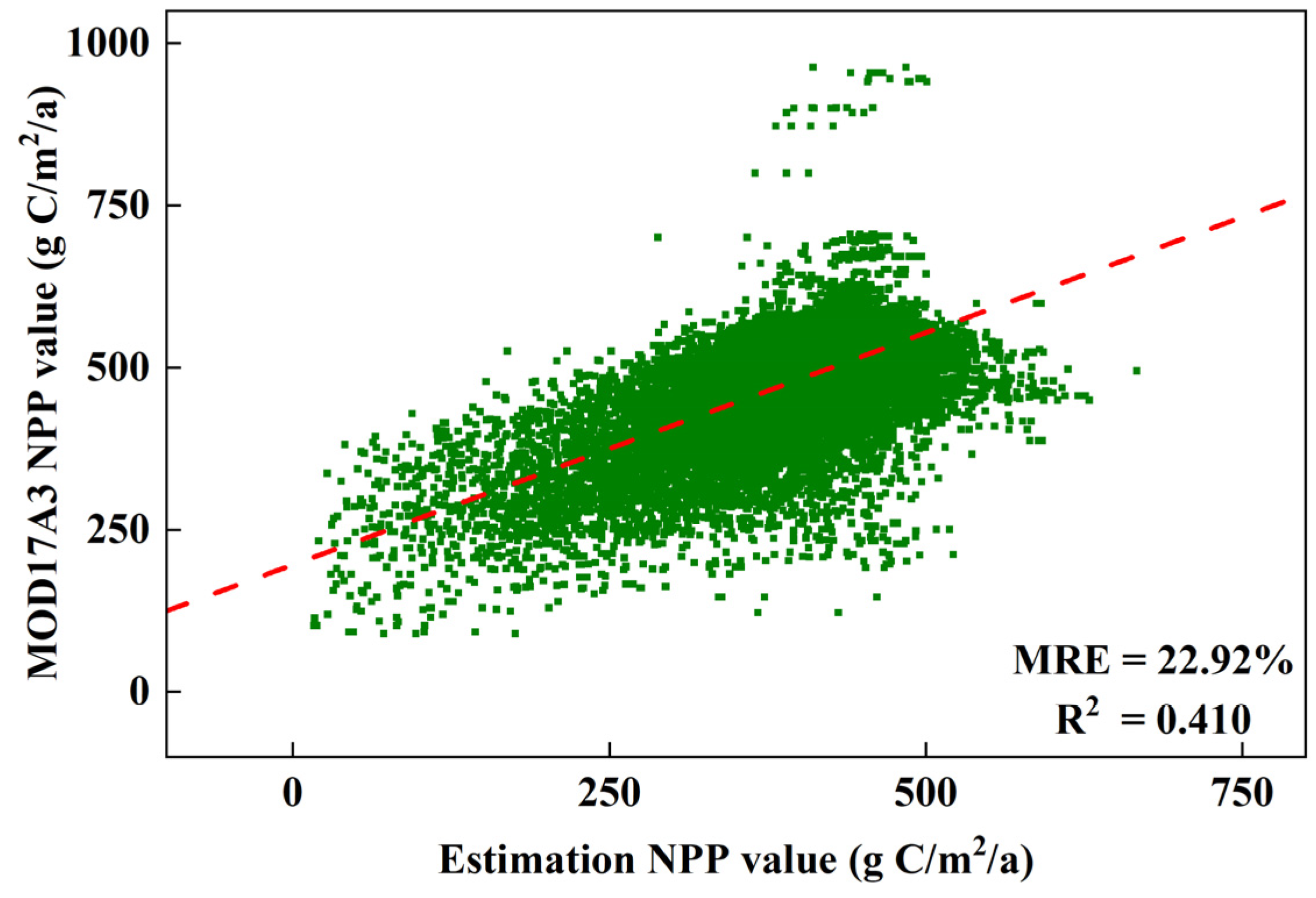
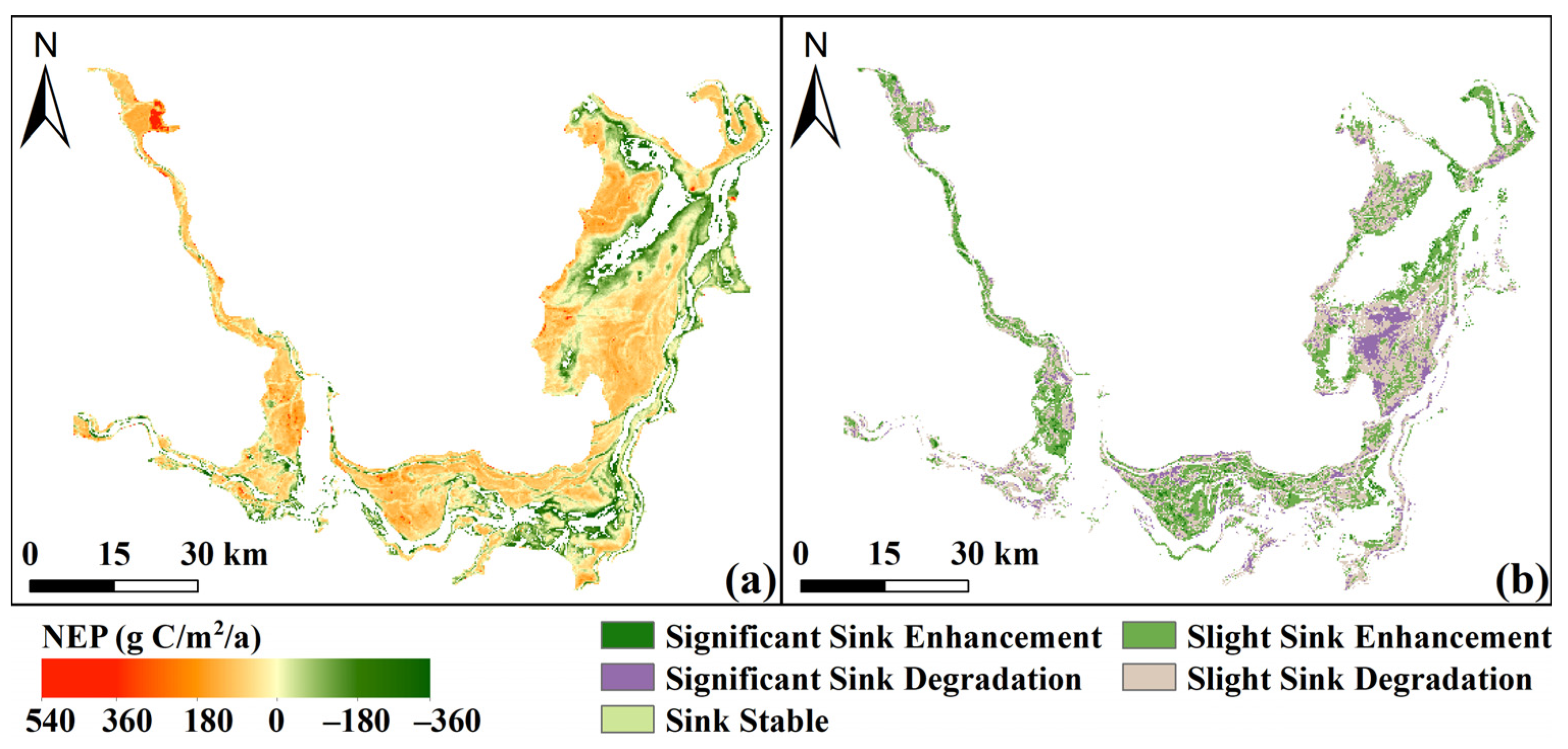



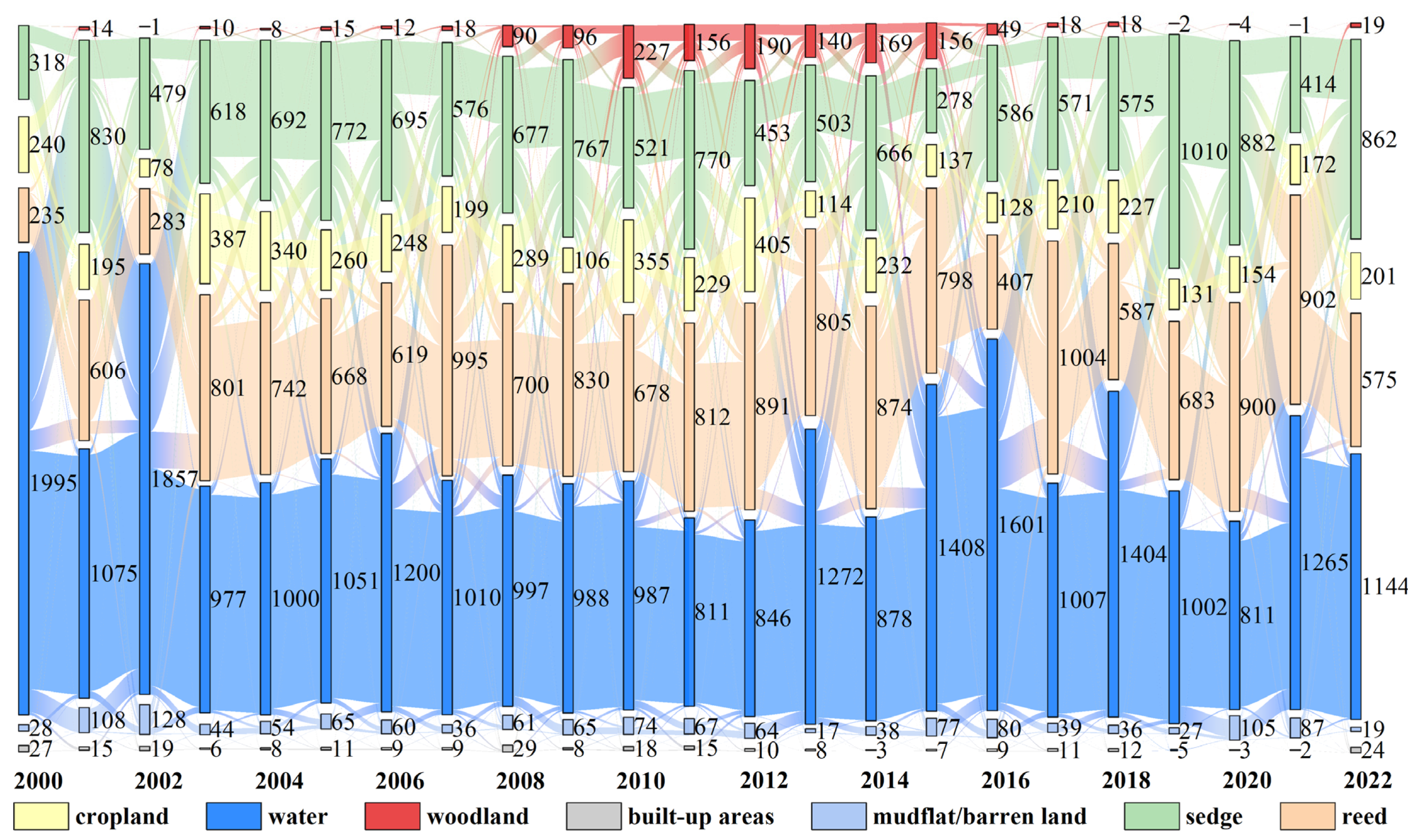

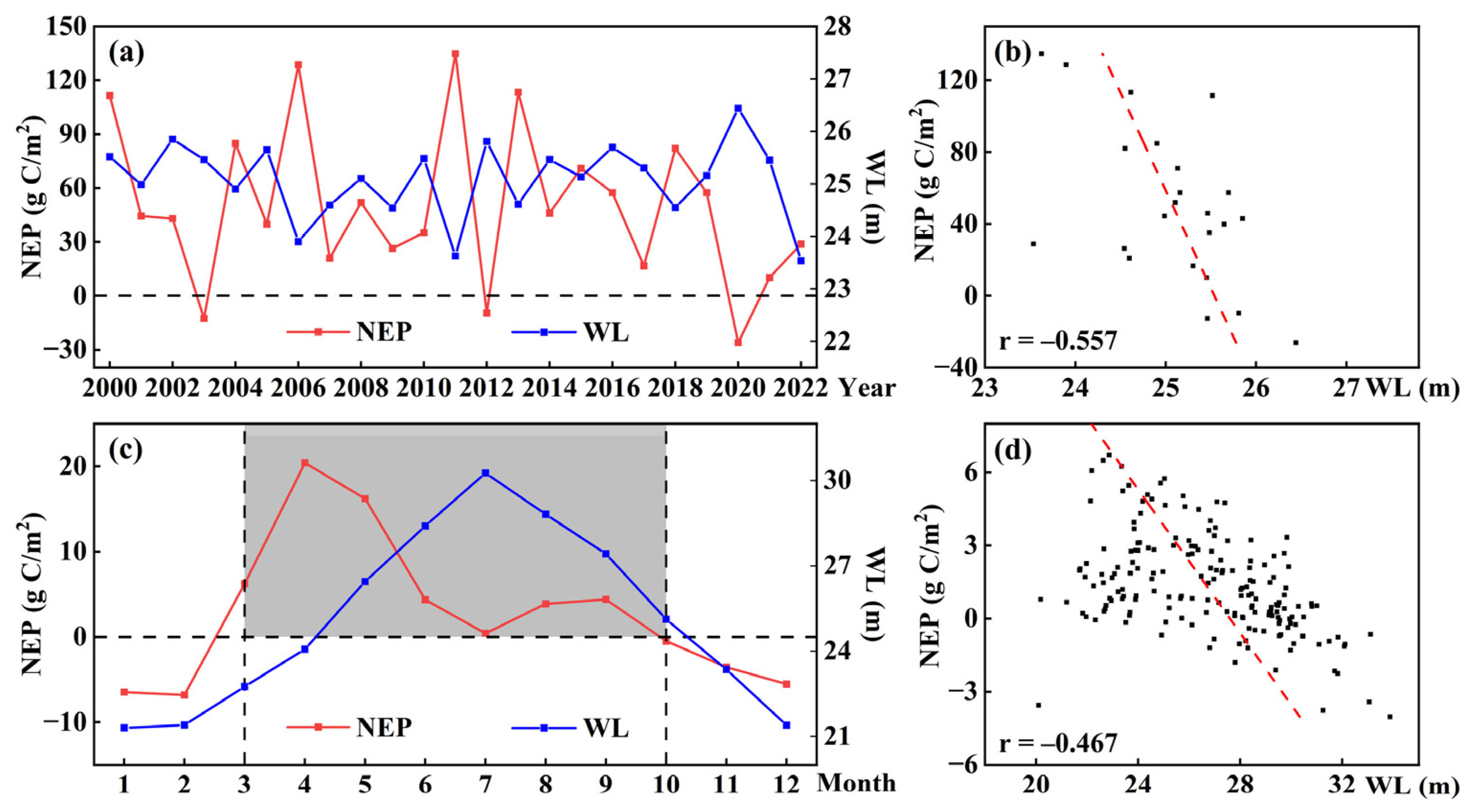
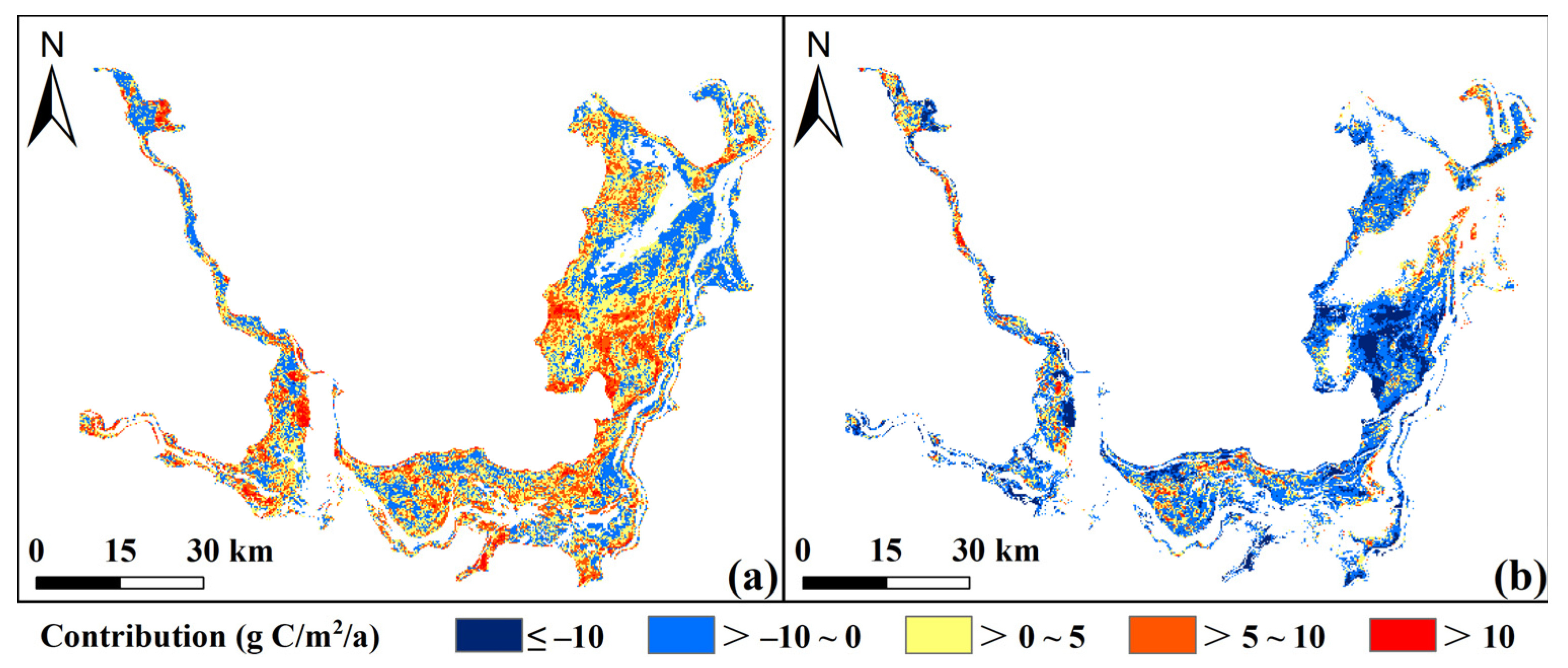
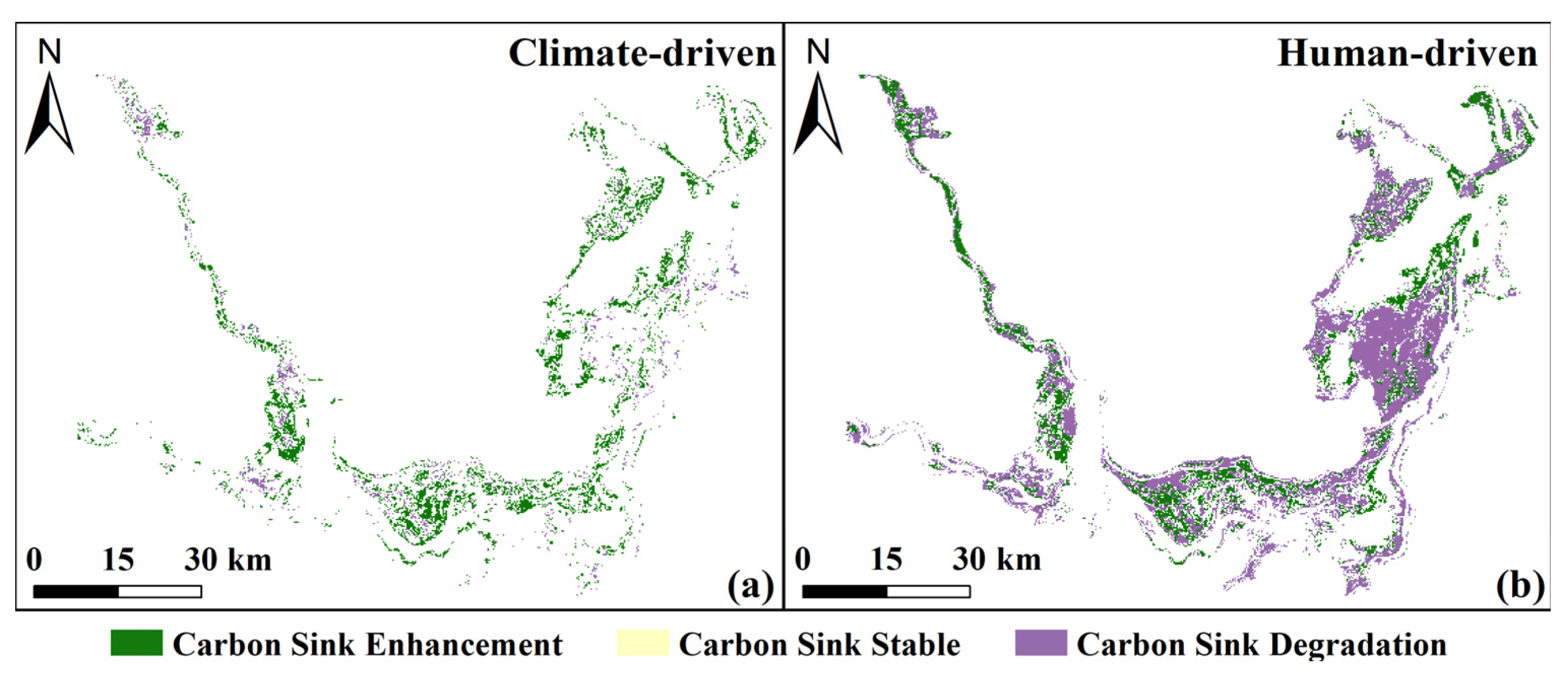
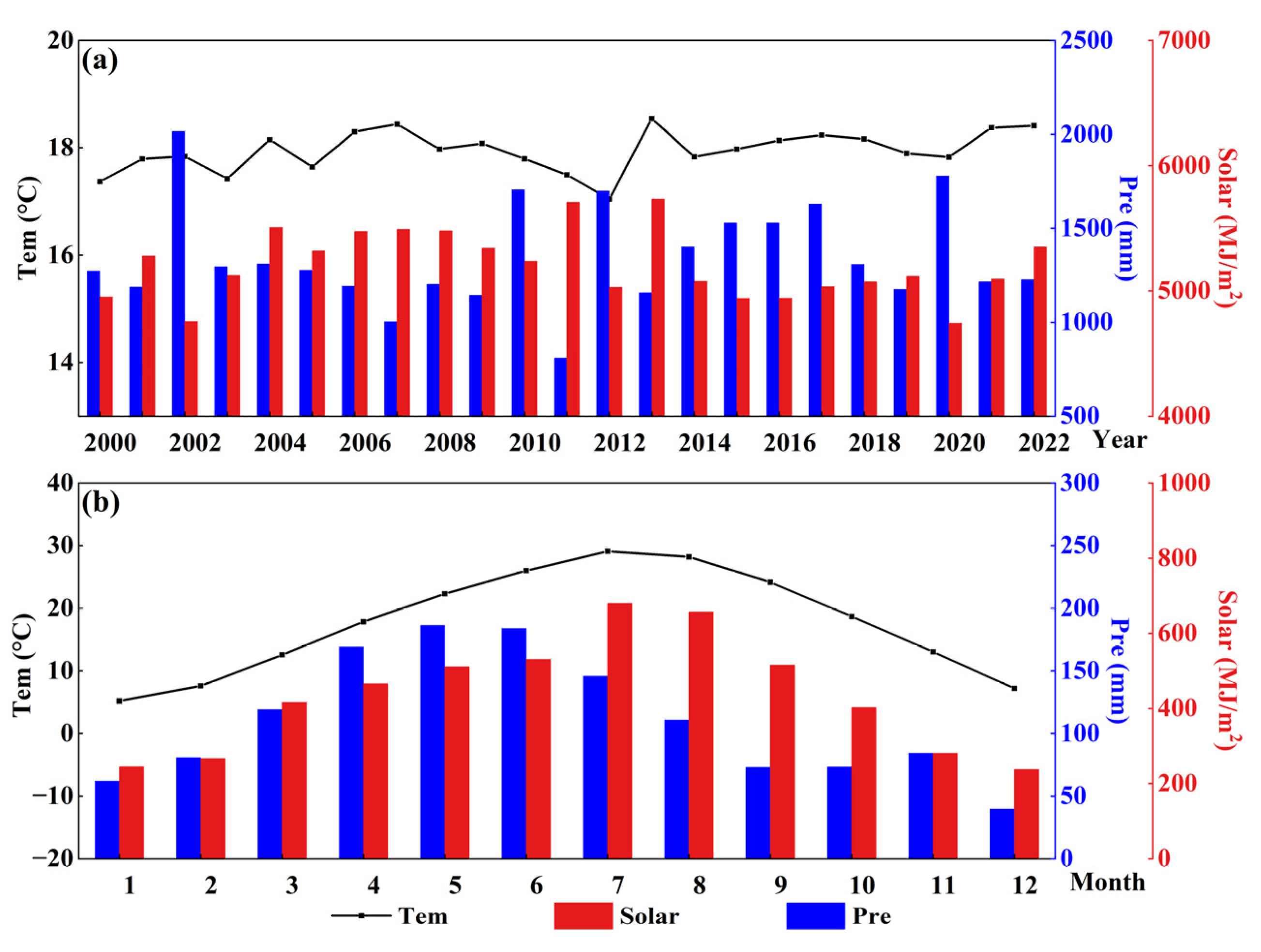
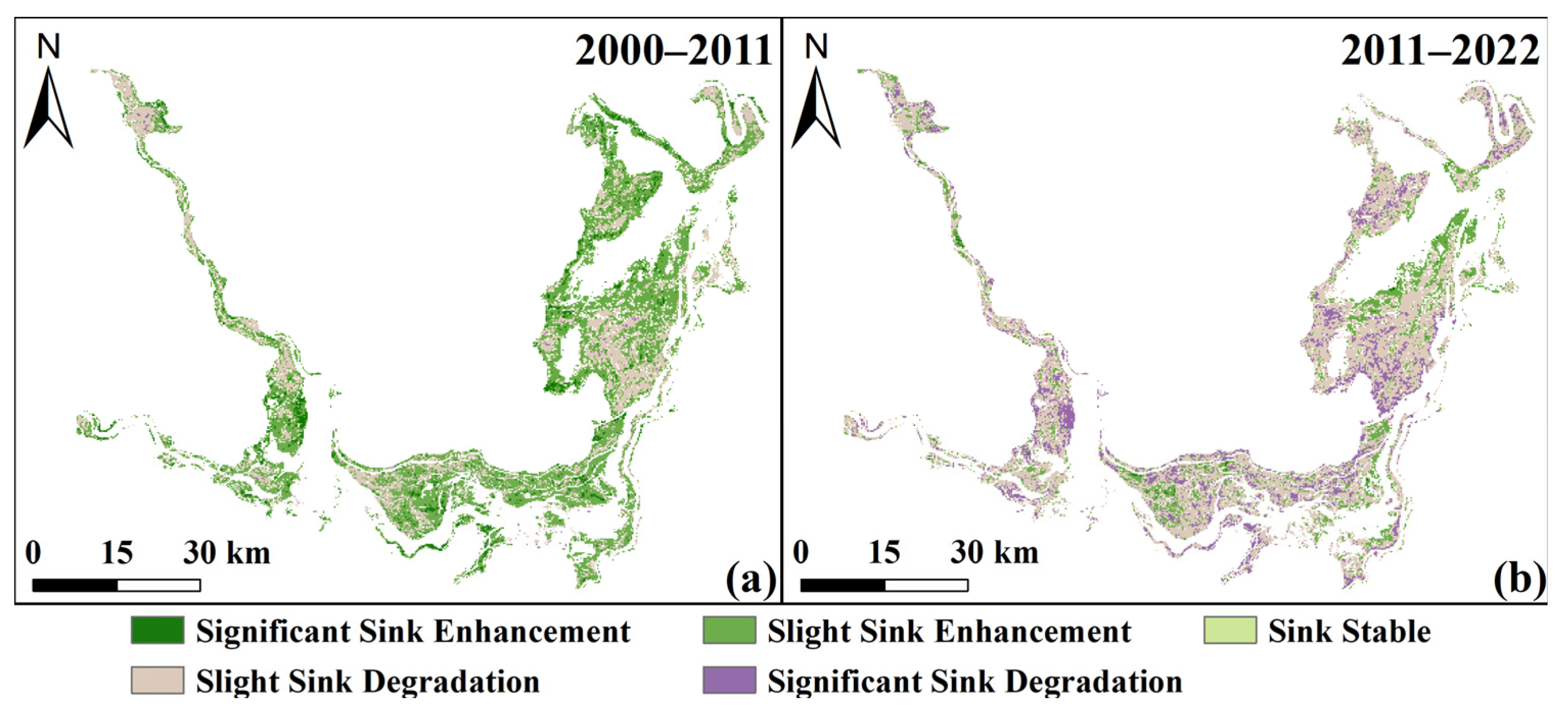
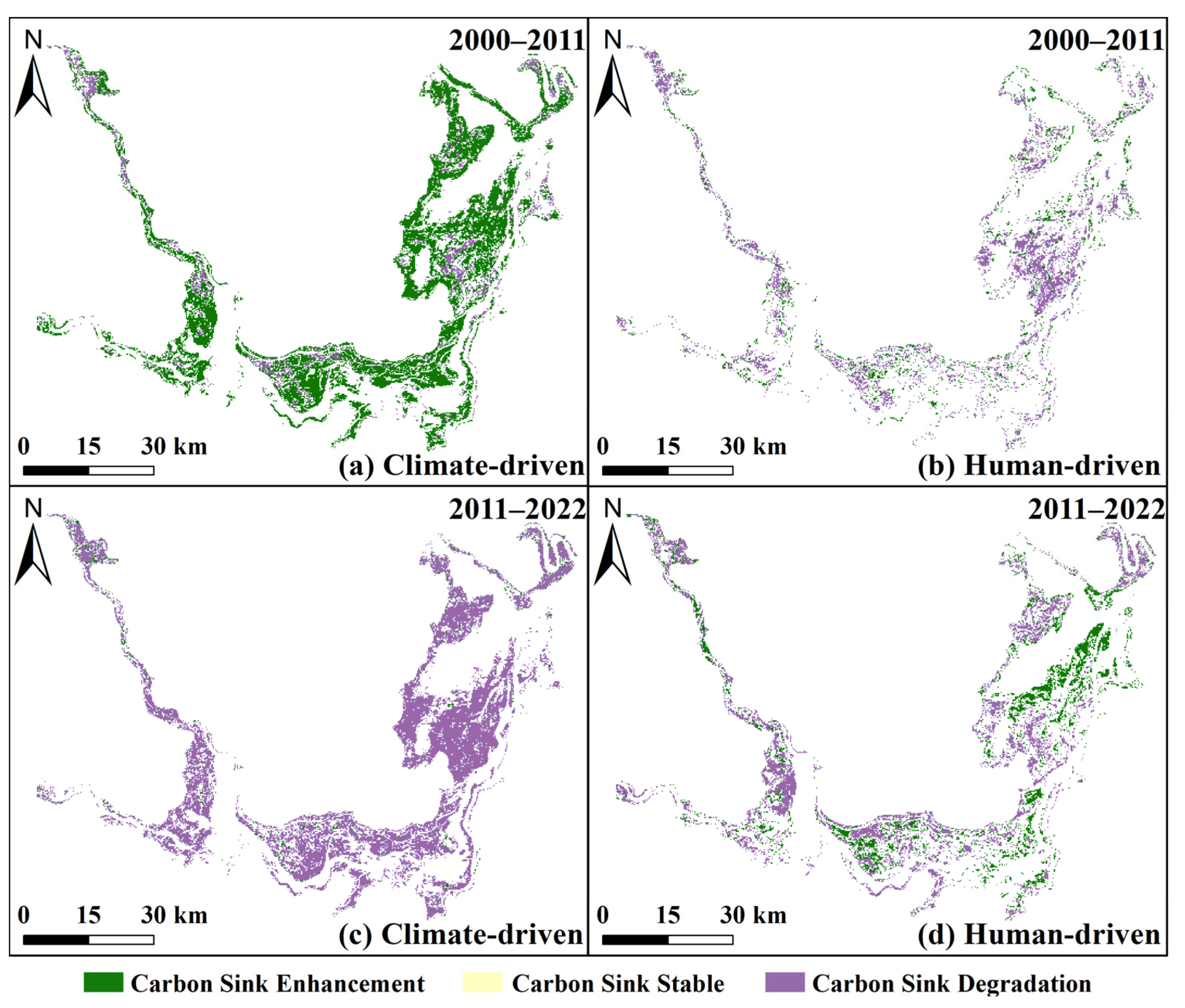
| β | |Z| | Change Pattern |
|---|---|---|
| >0.0005 | >1.96 | Significant Sink Enhancement |
| >0.0005 | ≤1.96 | Slight Sink Enhancement |
| [−0.0005, 0.0005] | ≤1.96 | Sink Stable |
| <−0.0005 | ≤1.96 | Slight Sink Degradation |
| <−0.0005 | >1.96 | Significant Sink Degradation |
| βNEP/(g C/m2/a) | Ccon/(g C/m2/a) | Hcon/(g C/m2/a) | Relative Impact/% | |
|---|---|---|---|---|
| Climate Change | Human Activities | |||
| >0.0005 | >0 | >0 | ||
| >0.0005 | >0 | <0 | 100 | 0 |
| >0.0005 | <0 | >0 | 0 | 100 |
| [−0.0005, 0.0005] | ||||
| <−0.0005 | <0 | <0 | ||
| <−0.0005 | <0 | >0 | 100 | 0 |
| <−0.0005 | >0 | <0 | 0 | 100 |
| Method | Period | Study Area | NPP Range (g C/m2/a) | Mean NPP (g C/m2/a) |
|---|---|---|---|---|
| CASA model | 2000–2022 | Dongting Lake wetland | 0~900.83 | 287.68 |
| Improved CASA [26] | 2000–2019 | Dongting Lake wetland area | 0~800 | 191.91 |
| CASA model [37] | 2017 | Dongting Lake wetland area | 0~768.30 | 232.6 |
| CASA model [45] | 2000–2022 | Dongting Lake Basin | 0~1300 | 399.86 |
| CASA model [46] | 2003–2018 | Dongting Lake wetland area | 1274.56 | |
| MOD17A3 NPP | 2001–2022 | Dongting Lake wetland | 55.44~1016.57 | 477.59 |
| Land Use Transition Type | From → To | Mean NEP Change | From → To | Mean NEP Change |
|---|---|---|---|---|
| Water–Vegetation Conversions | woodland → water | −34.03 | water → woodland | 54.93 |
| sedge → water | 44.37 | water → sedge | −39.28 | |
| cropland → water | 55.39 | water → cropland | −50.17 | |
| reed → water | 66.55 | water → reed | −68.95 | |
| Vegetation–Vegetation Conversions | woodland → sedge | −123.88 | sedge → woodland | 135.50 |
| woodland → reed | −270.43 | reed → woodland | 260.58 | |
| woodland → cropland | −99.09 | cropland → woodland | 109.57 | |
| sedge → reed | −119.73 | reed → sedge | 116.38 | |
| sedge → cropland | 20.19 | cropland → sedge | −17.24 | |
| cropland → reed | −139.41 | reed → cropland | 129.25 |
Disclaimer/Publisher’s Note: The statements, opinions and data contained in all publications are solely those of the individual author(s) and contributor(s) and not of MDPI and/or the editor(s). MDPI and/or the editor(s) disclaim responsibility for any injury to people or property resulting from any ideas, methods, instructions or products referred to in the content. |
© 2025 by the authors. Licensee MDPI, Basel, Switzerland. This article is an open access article distributed under the terms and conditions of the Creative Commons Attribution (CC BY) license (https://creativecommons.org/licenses/by/4.0/).
Share and Cite
Guo, M.; Zhou, N.; Cai, Y.; Wang, X.; Zhang, X.; Lu, S.; Liu, K.; Zhao, W. Quantitative Estimation of Vegetation Carbon Source/Sink and Its Response to Climate Variability and Anthropogenic Activities in Dongting Lake Wetland, China. Remote Sens. 2025, 17, 2475. https://doi.org/10.3390/rs17142475
Guo M, Zhou N, Cai Y, Wang X, Zhang X, Lu S, Liu K, Zhao W. Quantitative Estimation of Vegetation Carbon Source/Sink and Its Response to Climate Variability and Anthropogenic Activities in Dongting Lake Wetland, China. Remote Sensing. 2025; 17(14):2475. https://doi.org/10.3390/rs17142475
Chicago/Turabian StyleGuo, Mengshen, Nianqing Zhou, Yi Cai, Xihua Wang, Xun Zhang, Shuaishuai Lu, Kehao Liu, and Wengang Zhao. 2025. "Quantitative Estimation of Vegetation Carbon Source/Sink and Its Response to Climate Variability and Anthropogenic Activities in Dongting Lake Wetland, China" Remote Sensing 17, no. 14: 2475. https://doi.org/10.3390/rs17142475
APA StyleGuo, M., Zhou, N., Cai, Y., Wang, X., Zhang, X., Lu, S., Liu, K., & Zhao, W. (2025). Quantitative Estimation of Vegetation Carbon Source/Sink and Its Response to Climate Variability and Anthropogenic Activities in Dongting Lake Wetland, China. Remote Sensing, 17(14), 2475. https://doi.org/10.3390/rs17142475








